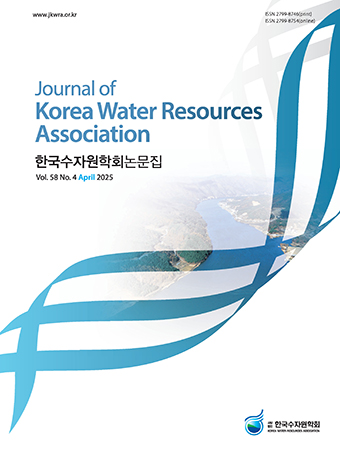Research Article
Abstract
References
Information
Brown, A., Zhang, L., McMahon, T., Western, A., and Vertessy, R., (2005). "A review of paired catchment studies for determining changes in water yield resulting from alterations in vegetation." Journal of Hydrology, Vol. 310 No. 1-4, pp. 28-61. doi: 10.1016/j.jhydrol.2004.12.010
10.1016/j.jhydrol.2004.12.010
Cao, Y., Ye, Y., Liang, L., Zhao, H., Jiang, Y., Wang, H., Yi, Z., Shang, Y., and Yan, D. (2019). "A modified particle filter-based data assimilation method for a high-precision 2D hydrodynamic model considering spatial-temporal variability of roughness: Simulation of dam-break flood inundation." Water Resources Research, Vol. 55, pp. 6049-6068. doi: 10.1029/2018WR023568
10.1029/2018WR023568
Choi, D., Yang, J., Chung, G., and Kim, S. (2011). "A conceptual soil water model of catchment water balance: Which hydrologic components are needed to calibrated the model?" Journal of the Korean Society of Civil Engineers, Vol. 31, No. 3B, pp. 211-220. doi: 10.12652/Ksce.2011.31.3B.211 (in Korean)
10.12652/Ksce.2011.31.3B.211
Choi, J., Lee, O., Won, J., and Kim. S. (2020). "Stochastic simple hydrologic partitioning model associated with Markov chain Monte Carlo and ensemble Kalman filter." Journal of Korean Society on Water Environment, Vol. 36, No. 5, pp. 353-363. doi: 10.15681/KSWE.2020.36.5.353 (in Korean)
10.15681/KSWE.2020.36.5.353
Clark, M., Rupp, D., Woods, R., Zheng, X., Ibbitt, R., Slater, A., Schmidt, J., and Uddstrom, M. (2008). "Hydrological data assimilation with the ensemble Kalman filter: Use of streamflow observations to update states in a distributed hydrological model." Advances in Water Resources, Vol. 31, No. 10, pp. 1309-1324. doi: 10.1016/j.advwatres.2008.06.005
10.1016/j.advwatres.2008.06.005
Fan, Y., Huang, G., Baetz, B., Li, Y., Huang, K., Chen, X., and Gao, M. (2017). "Development of integrated approaches for hydrological data assimilation through combination of ensemble Kalman filter and particle filter methods." Journal of Hydrology, Vol. 550, pp. 412-426. doi: 10.1016/j.jhydrol.2017.05.010
10.1016/j.jhydrol.2017.05.010
Lee, D., Kim, Y., Yu, W., and Lee, G. (2017). "Evaluation on applicability of on/off-line parameter calibration techniques in rainfall-runoff modeling." Journal of Korea Water Resources Association, Vol. 50, No. 4, pp. 241-252. doi: 10.3741/JKWRA.2017.50.4.241 (in Korean)
10.3741/JKWRA.2017.50.4.241
Pathiraja, S., Anghileri, D., Burlando, P., Sharma, A., Marshall, L., and Moradkhani, H. (2018). "Insights on the impact of systematic model errors on data assimilation performance in changing catchments." Advances in Water Resources, Vol. 113, pp. 202-222. doi: 10.1016/j.advwatres.2017.12.006
10.1016/j.advwatres.2017.12.006
Thirel, G., Andreassian, V., Perrin, C., Audouy, J., Berthet, L., Edwards, P. Folton, N., Furusho, C., Kuentz, A., Lerat, J., Lindstrom, G., Martin, E., Mathevet, T., Merz, R., Parajka, J., Ruelland, D., and Vaze, J. (2015). "Hydrology under change: An evaluation protocol to investigate how hydrological models deal with changing catchments." Hydrological Sciences Journal, Vol. 60, No. 7-8, pp. 1184-1199. doi: 10.1080/02626667.2014.967248
10.1080/02626667.2014.967248
Vaze, J., Post, D., Chiew, F., Perraud, J., Viney, N., and Teng, J. (2010). "Climate non-stationarity-validity of calibrated rainfall-runoff models for use in climate change studies." Journal of Hydrology, Vol. 394, No. 3-4, pp. 447-457. doi: 10.1016/j.jhydrol.2010.09.018
10.1016/j.jhydrol.2010.09.018
Xiong, L., Liu, P., Cheng, L., Deng, C., Gui, Z., Zhang, X., and Liu, Y. (2019). "Identifying time-varying hydrological model parameters to improve simulation efficiency by the ensemble Kalman filter: A joint assimilation of streamflow and actual evapotranspiration." Journal of Hydrology, Vol. 568, pp. 758-768. doi: 10.1016/j.jhydrol.2018.11.038
10.1016/j.jhydrol.2018.11.038
- Publisher :KOREA WATER RESOURECES ASSOCIATION
- Publisher(Ko) :한국수자원학회
- Journal Title :Journal of Korea Water Resources Association
- Journal Title(Ko) :한국수자원학회 논문집
- Volume : 54
- No :6
- Pages :365-379
- Received Date : 2021-02-16
- Revised Date : 2021-04-19
- Accepted Date : 2021-04-19
- DOI :https://doi.org/10.3741/JKWRA.2021.54.6.365




 Journal of Korea Water Resources Association
Journal of Korea Water Resources Association










